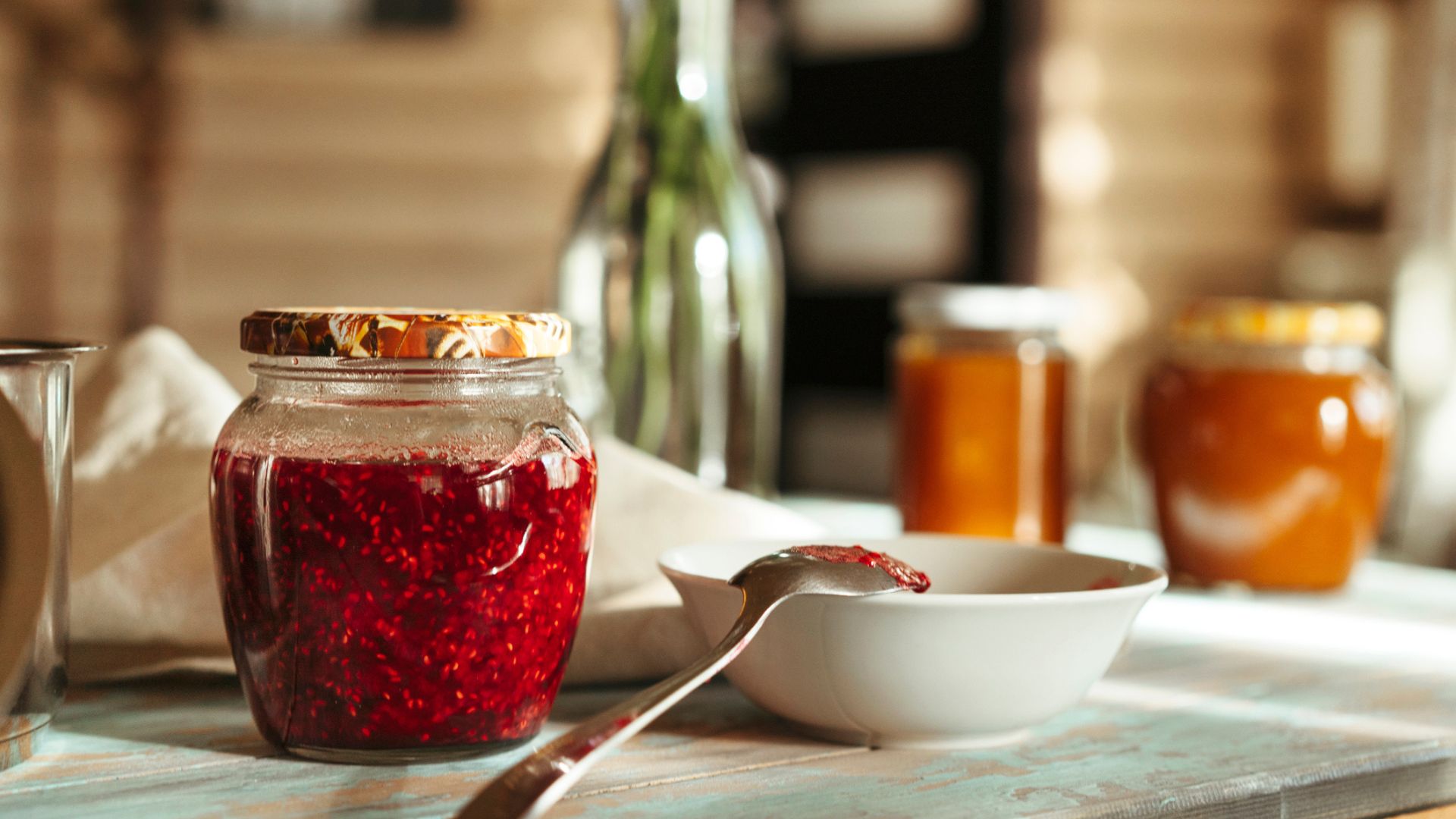Why is my jam not setting? How to fix runny jam and other common mistakes
Found yourself in a sticky situation? Deputy Food Editor at Future plc, Rose Fooks, is here to help you fix the most common jam mistakes


We’ve all been there, with a sticky mess congealed in the bottom of our best saucepans and the damning realization that something has gone horribly wrong with our homemade jam. Luckily, all is not lost, as the most common jam mistakes can be easily fixed.
Jam is a wonderful way to preserve a glut of fruit and always fills your home with a glorious sweet aroma. If properly jarred and stored, it will last for ages. A jar of homemade jam makes for a lovely personal gift, whether you're looking for a sustainable Christmas gift, or one of the best housewarming gifts. It's also a fantastic addition to many of the best easy dessert recipes.
Aside from its gift credentials, making jam at home can be very rewarding. But unfortunately, the results may not always be perfect. Is your homemade jam too runny, or thick? Does it have white bits? We've put together some common mistakes and tips on how to avoid them.
Why is my jam too runny?
This is a very common mishap and can occur for a couple of reasons. It may be because there is not enough pectin and acid in the mixture. Or it may be because the temperature of 104C was not reached when cooking.
While hot the jam will seem runny, but be patient, as it takes a while to cool and set. Samuel Goldsmiths, woman&home Food Editor has a nifty trick to test if the jam will set firm. “I always put teaspoons in the freezer and then dip in the jam when I think it’s done. If the jam sets on the spoon when I put the spoon in and out quickly then I know the jam will set," he advises.
Jam that was not heated to 104C-105C will not be set. In this is the case, heat the jam again. Use a jam thermometer to check when it reaches temperature.
However, if the jam has been heated sufficiently, but still did not set, then it requires more pectin and acid.
Sign up to our free daily email for the latest royal and entertainment news, interesting opinion, expert advice on styling and beauty trends, and no-nonsense guides to the health and wellness questions you want answered.
The easiest way to add both acid and pectin to jam is simply by adding lemon juice. Lemon juice contains both in abundance. The ratio we use when making jam is 1tbsp of lemon juice to every 1kg of fruit. woman&Home Food Writer, Keiron George, advises, “If you’re having trouble with setting your jam, bring it to the boil again, adding the rind of a lemon for some extra pectin”.
If in doubt, always read the manufacturer's instructions as different fruits contain different amounts of pectin. "Always use tried and tested recipes to understand the ingredient and liquid quantities and techniques for achieving successful natural sets," adds Elspeth Biltoft, owner of Rosebud Preserves . "Also, carefully follow the manufacturer's guide to using pectin."
What fruits are high in pectin?
Some fruits are naturally high in pectin and acid. Fruits rich in pectin and acid such as apple, blackcurrants, gooseberries and redcurrants will set a jam firm with little additions. However other fruits with lower pectin content will require a helping hand. Raspberries, plums and apricots all fit into this category. Strawberries, melon and cherries do not contain any pectin. Therefore when making jam with these fruits it is essential to add pectin in order for the jam to set.

Why is my jam too thick?
Fruits that are high in pectin such as apple, citrus fruits and pear will produce thick jams. The standard ratio in jam is equal measures of sugar to fruit. However, you may notice that recipes for jams made using high pectin fruits contain more sugar. This is to give the jam a better, less firm, consistency.
It's too late to add more sugar if the jam has already set and cooled. In this case, it can be thinned out by mixing in a little sugar syrup. If the jam is very firm and has a rubbery consistency, gently warm it while adding the syrup. But do not bring it to the boil again.
Sugar syrup is a mixture of equal amounts of water and sugar. The sugar is dissolved in the water by heating them together and stirring. Mixing in sugar syrup should give the jam a better consistency. However, it may also affect the shelf life. Therefore we would recommend that you only add sugar to one jar at a time and store it in the fridge.
Why does jam taste bitter?
Your jam may taste bitter because it's over-cooked. Sometimes overcooked jam can be a good thing, as it has a nice caramel flavor that will work well used in desserts. However, if it’s really overcooked the sugar will give it a bitter burnt taste. Sadly if the jam is burnt it’s beyond saving.
Why does my jam have white lumps in it?
If you've spotted white lumps in your jam, it is most likely sugar crystals. When making jam try to limit the amount of stirring you do after adding the sugar. Sometimes mixing the sugar will encourage it to crystallize.
"White lumps in jam are generally sugar that has crystallized and hardened. The secret is to dissolve sugar thoroughly over very low heat by stirring slowly and gently, frequently checking the liquid on your wooden spoon to make sure all the sugar crystals have dissolved before the temperature is increased to achieve a rolling boil," advises Elspeth.
Although it might not look perfect, there's no need to worry about these white lumps - it will still taste alright.
Why is my jam cloudy?
Despite your best efforts, sometimes the jam will just go cloudy. This may have been caused by the sugar, which may have crystallized during the cooking process. Another common cause may be the 'scum' which has surfaced to the top of the jam during cooking - it's very important you skim this off while cooking, to avoid this cloudy effect. There is nothing you can do to fix this in retrospect. However it’s not a deal breaker, and the jam should still taste equally as delicious.
When making jam, it’s best to skim off the scum using a slotted spoon while the jam is cooking. Or, to stop it from forming add 1/2 tbsp of glycerine (for every 1kg of fruit) once the sugar has dissolved.

Why has my jam gone mouldy?
Sometimes jam goes mouldy. It may be because bacteria was trapped in the jar, or it may be because the recipe did not contain a sufficient amount of sugar to preserve the fruit. It’s imperative when making jam that the jars are sterile. If they contain bacteria this will cause mould.
Pour hot jam into the jars and put a piece of wax paper neatly on top of the jam, wax side down, ensuring there are no air bubbles. Allow the jam to cool before firmly screwing on airtight lids. It’s safest not to risk eating jam which has started growing mould.
Now that you've solved all your most common jam mistakes, it's time to turn your attention to storage. Luckily we have the answers to your most-asked storage question too.
How long does homemade jam last for?
Elspeth advises keeping homemade jam for one year, but in most cases it can last longer than this, "I would recommend one year only, ideally eat all you have made before then and make fresh at the start of every season."
She adds: "Homemade jam, if it has been made correctly, will last for one and a half to two years but although it should still be safe to eat it will have lost all its brightness and fresh flavour."
Can I freeze homemade jam?
Yes, you can freeze homemade jam, for up to 12 months. But as explained before, jam generally keeps in the pantry for a long time, so freezing might not always be preferable.
If you do want to freeze your jam, ensure it's cooked and properly set, before packing it in a freezable, tightly sealed container with around 1/2 inch at the top to allow the jam room to expand. When frozen, your jam may go cloudy, but it will generally return to a clear color once thawed. The consistency might change a little too once you thaw it; simply mix it with a spoon to get it back to its right form.
Rose Fooks is the Deputy Food Editor at woman&home. Rose completed a degree in Art at Goldsmiths University before beginning her career in the restaurant industry as a commis chef at The Delaunay in 2015. She then worked at Zedel and went on to become part of the team that opened Islington’s popular Bellanger restaurant.
To hone her patissier skills, Rose joined the Diplome de Patisserie and Culinary Management course at Le Cordon Bleu. She ran a food market in Islington and cooked for a catering company that used only surplus food to supply events, before finding her way into publishing and food styling.
